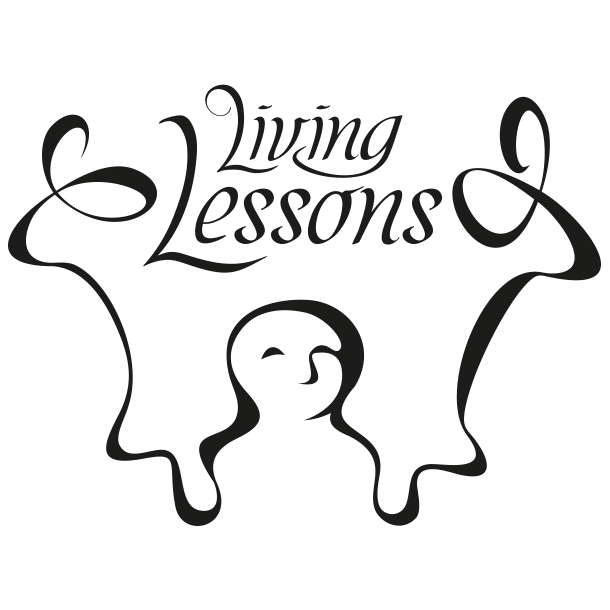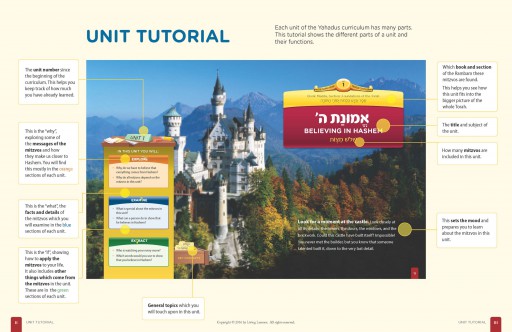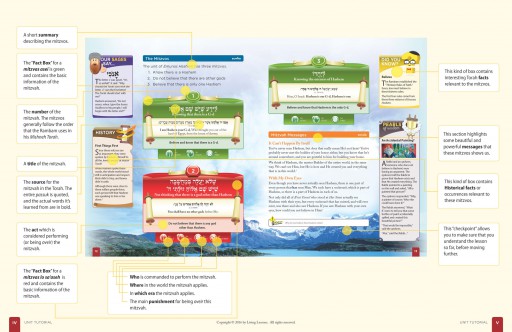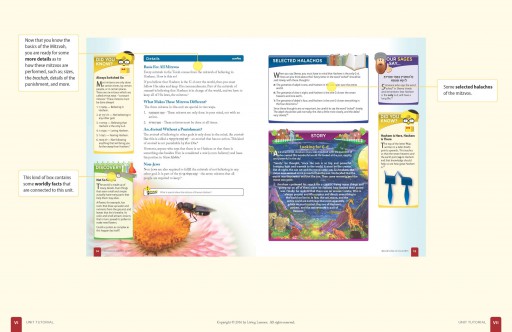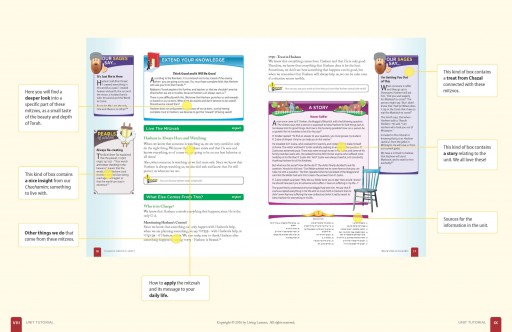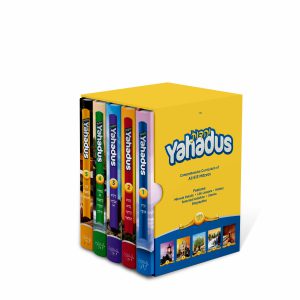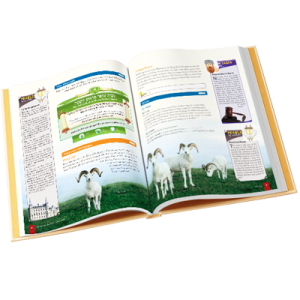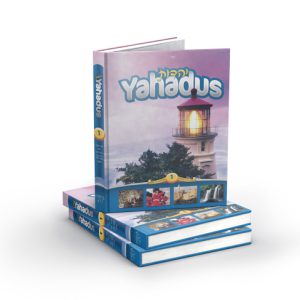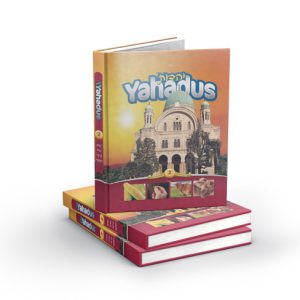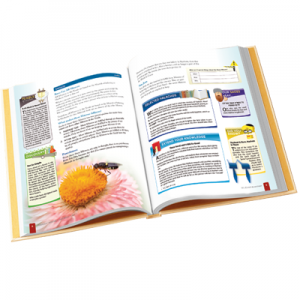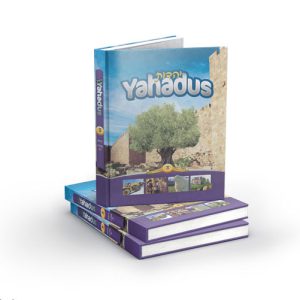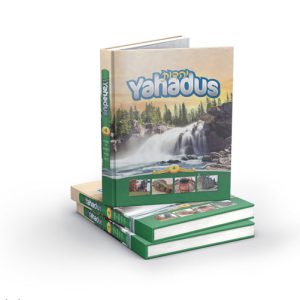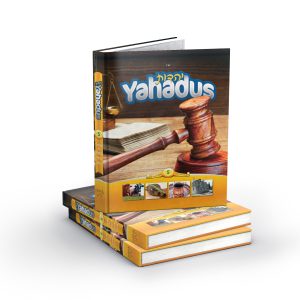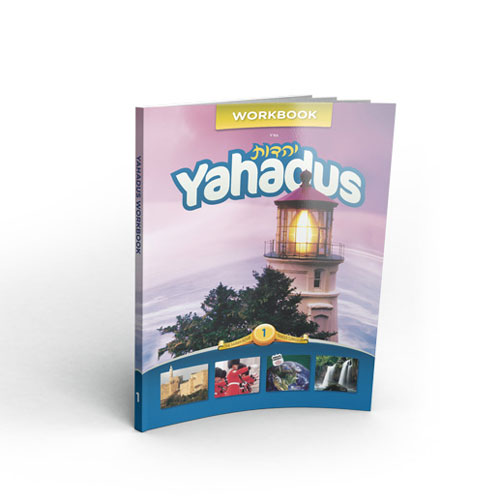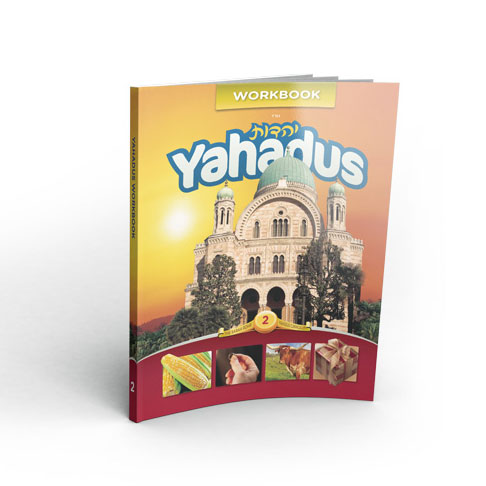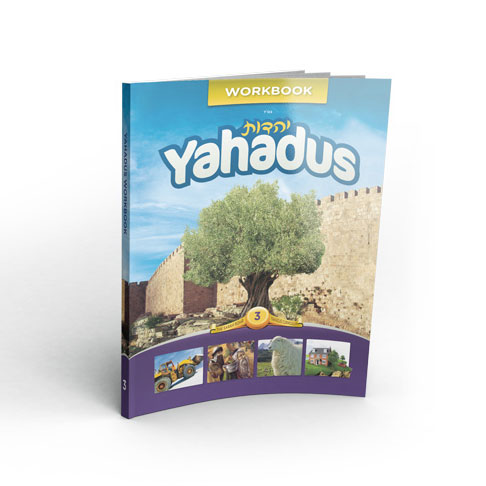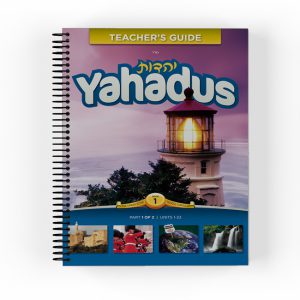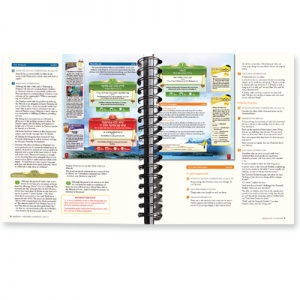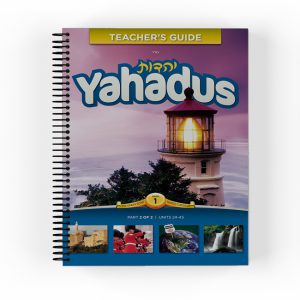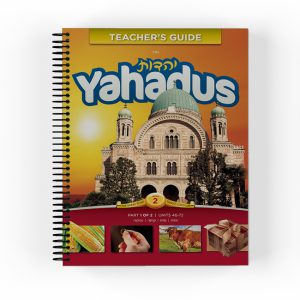About Yahadus
Student Textbooks
The Yahadus curriculum was created to give a strong overview of the entire Torah, using the Mitzvos as a framework. It includes a great amount of general Jewish information and can thus be used in place of, or as a complement to, a school’s existing Yahadus or Yedios Klaliyos curriculum. After one completes this curriculum, one will have some level of familiarity with every Mitzvah in Torah, plus a great portion of the many subjects discussed in the Torah. Since the wisdom in Torah is endless, careful thought went into selecting what information to include due to the reality of lesson time-constraints.
There are two categories of information in the Student Textbook:
- The main body information, including basic facts, laws and reasons for the Mitzvos in the unit, as well as its life applications and other areas of Jewish life which are connected to it.
- Optional information, which can be used or omitted according to each teacher’s discretion. This includes all the information that is placed in a separate sidebar or frame:
- Selected Halachos of the Mitzvah
- Extend Your Knowledge: A deeper look at a specific concept connected to the unit.
- Our Sages Say: Sayings or insights from Chazal.
- Did You Know: Interesting Torah facts related to the unit.
- Pearls of Wisdom: Insights culled from a wide range of Rishonim and Achronim.
- Stories: Short, insightful stories about a wide variety of our greats, connected with the unit.
- Biographies: Very short biographical sketches of Gedolei Yisroel mentioned in the unit.
- History: Small historical anecdotes relating to the unit topic.
- Discovery: Tidbits of science or other general knowledge, carefully selected to highlight and complement the information in the unit.
Design
Much thought and planning went into the design and layout of the curriculum. In standing with our mission and belief that our children deserves only the best Torah learning, the design surpasses the highest quality curricula in secular subjects. The researched layout and design has three main goals:
- Visual appeal: to attract and retain the attention of children growing up in a world of vibrant color and image.
- Clarity: separating the main information from what is secondary.
- Color coding: to identify different types of information.
Teacher’s Guide
The Teacher’s Guide is a wraparound guide accompanying each Student Textbook. It is useful both to prepare the lesson, and for use as an aid during the lesson itself.
The Teacher’s Guide contains the following features:
Additional Information
The purpose of the additional information is:
- To supply the teacher with a more comprehensive understanding of the information in the Student’s Textbook
- To use at the teacher’s discretion to challenge children of differing capabilities, backgrounds and interests.
The additional information includes:
- Background information
- Different opinions regarding the information presented
- “Misconception alerts” to answer questions which students are likely to ask
- Additional reasons, details, fun facts, stories etc.
- Additional clarification of information presented in the Student Textbook
Focus
There are two features that assist in focusing the lesson.
- Enduring Understandings: Information can be taught simply as facts and bytes of knowledge, or to convey enduring a deeper understandings, messages and outlooks on life. Each unit has a number of such ‘understandings’ which the students can uncover via the information learned. These are are noted in the Teacher’s Guide in each section of the unit through which they can be discovered.
- Learning Objectives: Each section has a defined purpose providing the teacher with a clear goal and a means to measure whether the students have achieved that goal. This helps to keep the lesson focused and to avoid digressions or missing the point.
Presentation Ideas
- Suggested dialogues and explanations which can be used to introduce or discuss the information.
- Multisensory activities to reach all kinds of learners (V.A.K.T.)
- Answer keys to Checkpoint activities and review questions to assess whether the students mastered the unit.
Tests
- Assessment tests and answer sheets come prepared for each unit. The tests have varying types of questions to asses the students’ understanding and integration of the information learned.
Workbook
Each student textbook has an accompanying full-color workbook. The workbooks are packed with games, activities, review questions and more.
The workbook activities are designed to engage different kinds of learners, and to help the children assess whether they have mastered the concepts in each unit. They follow a system so that children will become familiar with the style of activities, and how they relate to the information in the textbook.
There are four general parts to the workbook:
- Checkpoints: These correspond to each color-coded section of the unit. Checkpoints are a place to stop and “check for understanding” before moving further in the lesson. Where applicable, they are designed to check whether the student has “got the point” of the information, rather than just memorized facts.
- Practice the Mitzvah: This activity is creatively designed to have the student do the mitzvah, or its message, “on paper.”
- Review and test preparation: These are review questions for the student to complete. Aimed to stimulate a range of “thinking skills,” they cover the fundamental elements of each unit, and help the student assess what they have learned.
- My Mitzvah: A place for each student to derive their own personal lesson from the information in the unit. Students can write how the information they have learned can impact their life. This is crucial in making the Torah that they learn into a “living lesson.”
The act of writing, combined with the creative style of the activities, aid in the integration and retention of the information.
Learning has never been so much fun!
Yahadus Curriculum Overview
Living Lessons’ flagship Yahadus curriculum gives a strong overview of the entire Torah over five years (fourth through eighth grade) with the mitzvos as a framework.
Each year, students learn approximately 120 Mitzvos, and the curriculum adjusts in content, language and design to suit the target age level.
- The Rambam’s order of the mitzvos, organized by subject, has been used, with rare exceptions. This logical sequence makes it much easier for children to connect to and retain the information.
- The curriculum starts in fourth grade with the mitzvos of Sefer Madda, and ends with Sefer Shoftim in eighth grade. There is one student textbook for each year. Four volumes are now available, with the fifth and final volume coming soon b’ezras Hashem. The textbooks are sturdy and designed to last for a number of years by the students in each grade.
- Each student textbook is accompanied by a two-part Teacher’s Guide, as well as a workbook with activities for the students to use.
Timeframe
While every school is constantly challenged to squeeze in everything they want to teach into their limited time resources – as they should be – this curriculum is a tremendous asset, as it can change the approach of the teachers and students to the entire learning process.
The curriculum also covers many aspects of any Jewish Studies curriculum, being that it goes through all 613 mitzvos, and thus may free up some of the time needed for them.
- It is designed to use approximately 90 minutes per week.
- The curriculum is built with much flexibility in the time it will use:
- It can be taught either in varying timeframes (1 – 2 longer sessions per week, or 3 – 4 shorter ones.)
- Much of the information is optional and the layout is designed to allow it to easily be included or omitted in classroom instruction based on time allowances.
- It reads easily and is visually attractive enough for students to take home and prepare varying amounts of the text before class.
Educational Model
We have researched and applied select elements from educational models, after consulting experienced mechanchim.
Everything that Hashem creates is for B’nei Yisrael and for Torah. Therefore, we can and must learn from the results of the millions of dollars and hours of research done (for us!) by the “world” of education, into the way children learn, comprehend and remember.
Based on research and consultation with experienced and knowledgeable mechanchim, we have selected certain elements from different models and methods and applied them to a Torah subject. While certain elements of instruction and theories of education were selected from various models and approaches, the urgency of maintaining our rich Mesorah was always at the top of the list and remained the highest priority.
Below is a brief summary of the elements employed from the different educational models.
- Understanding by Design
- Enduring Understandings: Information can be taught as facts and bytes of knowledge, or it can be used to convey enduring understandings, messages and outlooks. Each unit has a number of “understandings” which the students will “uncover” via the information learned. These are noted in the Teacher’s Guide in each section of the unit through which they can be discovered.
- Learning Objectives: Each section has a defined purpose, which provides the teacher with a clear goal, and a means to measure if they have achieved that goal. This helps to focus the teaching towards reaching the stated goal, and avoid digressions, or “missing the point.”
(For more on Understanding by Design, click here.)
- The 4MAT ModelThe 4MAT model organizes information into 4 categories which are the steps our brain goes through when learning new information, in this order:
- “Why” – The meaning, relevance and significance of the information. (Why am I learning this?”)
- “What” – The “facts” of the information (“What do the experts say?”)
- “How” – The practical application of the information (How is it done?)
- “If” – The extension of the information into other areas. (“If this is so, then what about …”)
People are usually strongest in one of the four areas, and tend to focus on and learn through a specific one of these modes.
The information in each unit follows this cycle, with the different parts of the information color coded, for the teacher and student to recognize what “kind” of information it is.
- Explore (Orange) – The “Why” of the unit; meaning, reasons, significance, life messages etc.
- Examine (Blue) – the “What” of the unit; facts, details, halachos, etc.
- Extract (Green) – The “If” of the unit; applying the messages to life, and connecting the Mitzvah to other aspects of Jewish life which are derived from or connect to the Mitzvos in the unit.
- The “How” is usually present in the form of a Textbook activity for the students to “perform” the Mitzvah or an element of it, on paper.
(For more elaboration on how the unit structure reflects 4MAT, see later in the “Unit Structure” section)
(For more on the 4MAT system, click here.)
- Multiple IntelligenceDifferent children learn best through different “forms of input.” This concept is addresses in the curriculum in the following two areas:
- There is additional information in the sidebars, which are varied to attract different kinds of learners with different interests.
- The Teacher’s Guide contains presentation ideas to reach different kinds of learners. Each unit contains at least one idea for the students to receive the information in each of the following methods of input:
- Visual
- Auditory
- Kinesthetic
- Tactile
(For more on the V.A.K.T. system, click here.)
- Differentiated InstructionStudents in every class and every school are on different general levels, and within each class there are also multiple levels of capabilities. The curriculum addresses this in the following two ways:
- There is “optional” information in the Student’s Textbook for a teacher to use at their discretion to challenge children of differing capabilities, backgrounds and interests.
- The Teacher’s Guide includes additional information for a teacher to use at their discretion to challenge children of differing capabilities, backgrounds and interests.
(For more on Differentiated Instruction, click here.)
